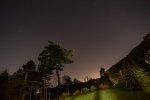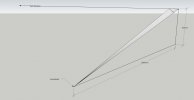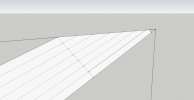1 second is a very long time in regular handheld photography. Especially for moving targets. When I shoot birds in flight I need 1/1000+ 1/2500 if I am shooting fast flight. 1/500 might get a you a fairly non motion blurred helicopter, obviously speed matters etc.
However it is low for pure dark skies astrophotography where you use longer exposure times generally 20+ seconds, depending on the lens aperture and how the need to avoid star trails.
I'm not sure 1 second or 20 is right for this shot though, but we would need ISO/aperture etc to know fully. Obviously releasing the full RAW photos is something any one who really wanted people to get to the bottom of this would do.
1 second makes no sense really, you wouldn't use it for astro and if something odd and bright flew over you'd need a faster shutter really. Unless you panicked.
Here's a shot I took in similar conditions, i.e. not really dark enough sky for the milky way in fairly local light polluted surrounds getting a similar number of the brighter local stars, the exposure time is 8 seconds at 3200 ISO probably f/4 as that's the max aperture of my manual wide angle.

Is it confirmed there are 4 different photos? Have they all been shown?
There are 8 blinks to the red light (helicopter anti-collision (AC) strobe?)
FAA says "
an effective flash frequency of not less than 40, nor more than 100 cycles per minute." for AC strobes
I used a tempo tap timer to time the AC strobe in this video of a H145
Source: https://www.youtube.com/watch?v=c-4izzGafrU
I got ~44 per minute or 0.733 every second meaning for 8 blobs to appear you would need an exposure time of ~11 seconds.
If it is an AC strobe then the exposure time is between ~12 seconds and ~4.7 seconds according to the FAA.
I wonder if strobes are set on aircraft by the manufacture or adjusted locally by the operator.
@Mick West I wonder if Mick has the exposure time for his helo shot.




